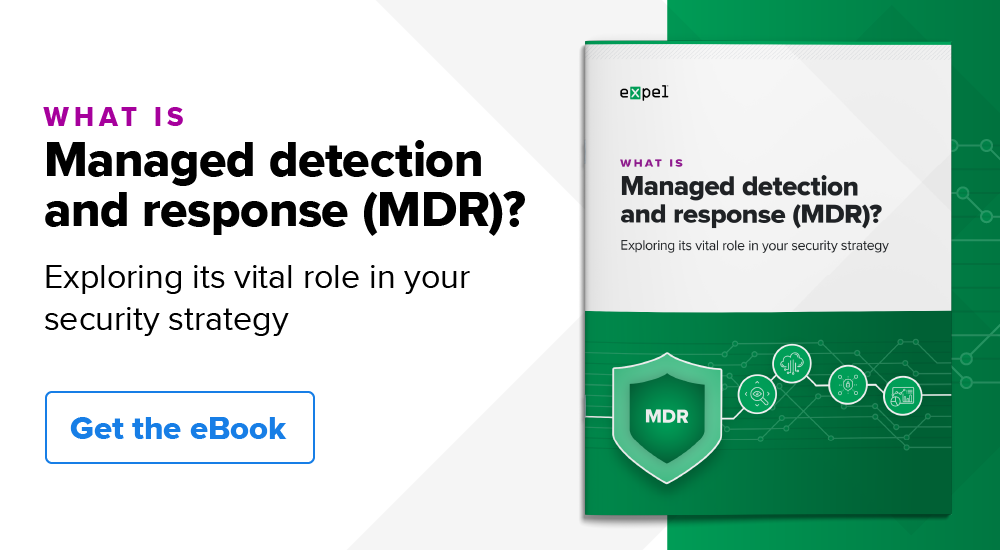Table of Contents
Managed detection and response (MDR) is a cybersecurity service that provides customers with remotely delivered security operations center (SOC) functions. MDR services rapidly detects, analyzes, investigates, and actively responds all the way through threat detection and response, disruption and containment.
Why is MDR important in today’s cybersecurity landscape?
There are three main reasons behind the rise in MDR:
- Security management is costly and time consuming, particularly because the dynamic threat landscape is constantly evolving. Security teams can easily be overwhelmed with alerts or caught off guard by new attack tactics, requiring a SOC that’s staffed 24×7. For these reasons, security management must be more strategic and flexible than ever. Plus, new technology is always on the horizon, and it’s impossible for security teams to be experts on onboarding, integrating, and managing it all.
- Security teams are also grappling with a years-long cybersecurity talent shortage, which 50% of security professionals cited as a top challenge in 2023. Security teams can’t fill vacancies fast enough, so organizations have leaned into adding MDR and AI to their tech stack.
- Security teams are suffering alert fatigue, overwhelmed by a flood of alerts. The barrage of false positives can lead even experienced security professionals to overlook genuine threats.
MDR providers can address these challenges and keep pace with modern cyberattackers with more powerful prevention, detection, rapid-response processes, and technology. The providers can also work as an extended security team, in partnership with in-house security staff. MDR providers evaluate security through strategic, business, and industry lenses, helping businesses proactively build cyber resilience.
What services does MDR provide?
Breadth of protection
MDR detects threats across all surfaces, including on-premises networks, the cloud, the network edge, remote endpoints, the software development process, and more.
Wide compatibility and integration
MDR providers can integrate with operational software and network infrastructure or with other security solutions such as remediation tools.
Automated workflows and analysis
A managed security services provider (MSSP) can analyze and curate alerts, but can still leave security teams with an unmanageable pile of work. By contrast, an MDR platform uses more advanced automations that include contextual factors for identity threats, providing more-focused analysis.
Tailored solutions
Every organization has unique security needs, maturity levels, and postures, yet many security solutions offer a one-size-fits-all approach. An MDR platform, however, can seamlessly integrate with existing hardware and software or help build robust security infrastructure from the ground up, tailoring its services to meet each organization’s specific requirements.
Expert staff
MDR is not just about automation and integrations. The technology must be backed by security experts who understand a business’s unique needs and can provide extra context in their analysis. Ideally, the business can consider those experts part of the in-house security or IT team.
High-level focus
Solving one security issue often leads to another. With the abundance of on-premise and SaaS security tools, threats can easily slip through the cracks, and the big picture may be overlooked. MDR providers offer a comprehensive organizational focus, leveraging deep knowledge of the business, its IT stack, and its risk profile. They provide recommendations to enhance security procedures and adjust operational structures as needed.
SOC capabilities
Building, staffing, and maintaining a state-of-the-art SOC is expensive. Most MDR providers offer 24×7 monitoring backed by staffed triage and response.
Continuous evolution
The security landscape changes daily . Threats intensify and new attack tactics continually appear. One of the most important capabilities an MDR can deliver is simply keeping a close watch on the security landscape and adjusting the security posture accordingly.
How does MDR compare to other security services?
SIEM
Security information and event management (SIEM) services gather, aggregate, and analyze security data throughout an organization’s networks. A good MDR solution builds on a SIEM’s work, and gets more value from it by automating more of the process, adding response and even remediation. Additionally, some MDR providers obsolete the SIEM approach entirely by connecting their software directly to an organization’s telemetry.
MSSP
Managed security service providers (MSSPs) assist in-house security analysts, but they still generate mountains of data that add to analysts’ workloads. MSSPs can attempt to manage the data loads of SIEM systems, but they face the same technical and staffing issues as their customers. This is in contrast to MDR providers that use automation to handle data loads, allowing them to scale more easily and add much-needed context for refined alert analysis.
EDR
Endpoint detection and response (EDR) security solutions collect detailed data from endpoints to establish a baseline of normal usage patterns. MDR providers were originally created as extensions of EDR services. But over time, MDR providers have superseded endpoint-exclusive solutions. Today’s MDR is designed to cover more threat surfaces, such as on-premises, the cloud, and even internal operations infrastructure.
SOC
A security operations center (SOC) is an IT security team that detects, analyzes, and responds to security incidents in real time. The SOC is a core function of today’s MDR providers, providing staff 24×7 to respond to network threats as they happen.
CDR
Cloud detection and response (CDR) detects suspicious activity in real time, including remote code execution, malware, crypto-mining, lateral movement, privilege escalation, and container escape. Cloud detection and response (CDR) is essentially MDR for cloud deployments and is usually included in MDR solutions.
Benefits of MDR
Today’s organizations face increasingly sophisticated threats while managing resource constraints. MDR providers deliver critical advantages by providing round-the-clock security expertise without the overhead of fully staffing a 24×7 internal team. This approach offers immediate access to specialized threat analysts who continuously monitor environments when internal teams are unavailable.
By implementing proven detection methodologies and automated response workflows, MDR significantly shortens threat identification timeframes and containment periods. Advanced hunting capabilities uncover stealthy adversaries that might evade traditional security controls. Organizations also strengthen their compliance programs through systematic monitoring and comprehensive security documentation.
The flexible nature of MDR allows security coverage to expand alongside business growth without proportional resource investments. By effectively triaging alerts and eliminating noise, MDR ensures security teams focus on genuine threats rather than false positives. When incidents occur, swift expert response minimizes operational impact and protects organizational reputation.
How Expel approaches MDR
Expel Managed Detection and Response (Expel MDR) helps you quickly find and stop security threats across your entire technology environment. The service monitors your endpoints, cloud systems, Kubernetes, SaaS applications, network, SIEM, email, and identity platforms to catch threats early. When suspicious activity is detected, Expel’s security experts work directly with your team to confirm threats, take immediate action to contain them, and provide clear documentation explaining what happened, where it occurred, when it was detected, and how it unfolded—all in real-time.




